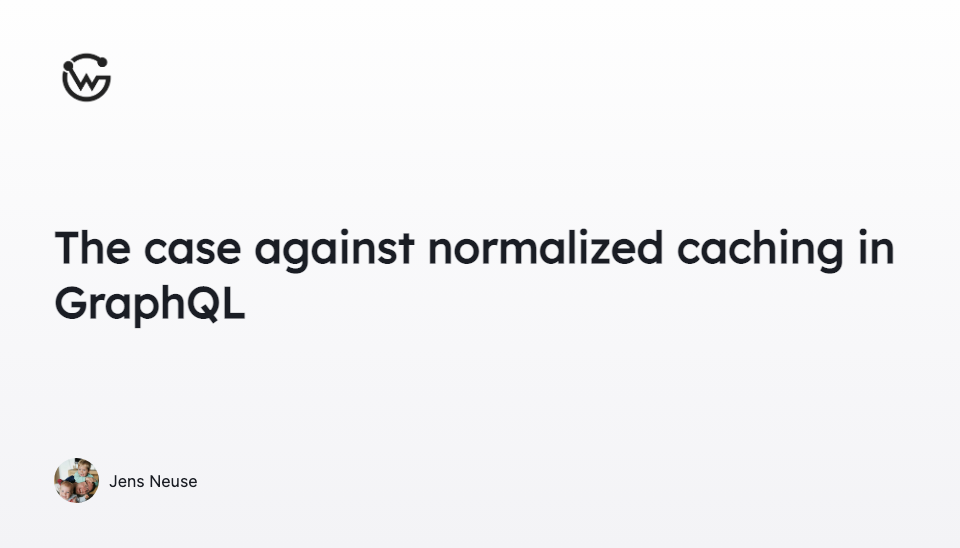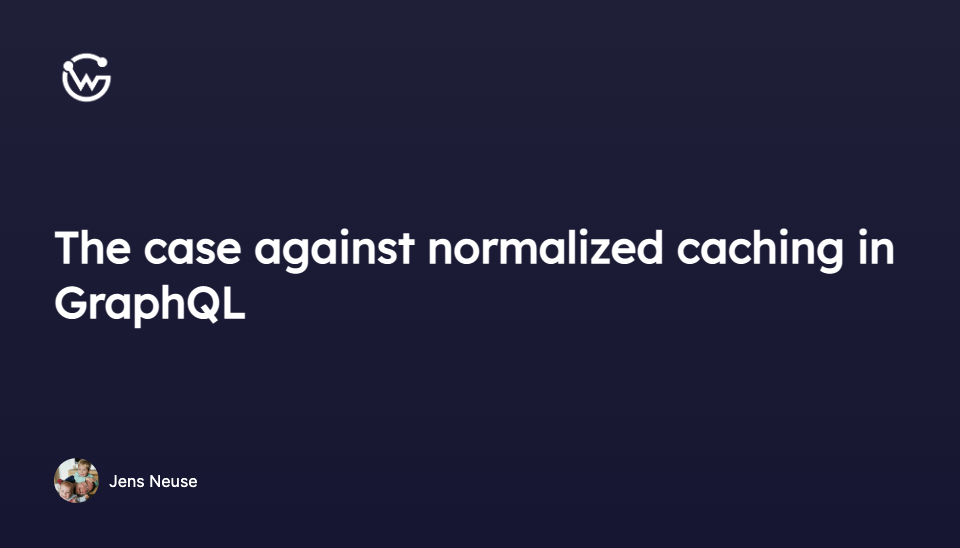The case against normalized caching in GraphQL


Jens Neuse
Introducing WunderGraph Hub: Rethinking How Teams Build APIs
WunderGraph Hub is our new collaborative platform for designing, evolving, and shipping APIs together. It’s a design-first workspace that brings schema design, mocks, and workflows into one place.
In this post we'll compare rich GraphQL clients that come with a normalized cache implementation and the generated WunderGraph clients that rely on HTTP caching.
As you might have already found out, WunderGraph uses persisted queries by default. With the WunderGraph code generator (https://www.npmjs.com/package/@wundergraph/sdk) you can generate a client that knows exactly how to invoke your previously registered operations. With the @cache directive you're able to configure that the response of an operation should be cached by the server & client. Cache Control headers will be set accordingly, including etags. This mechanism is fully compatible with all major browsers and CDN's who implement caching according to the HTTP Caching RFC .
To illustrate this a bit better I'd like to introduce two example queries. The first one fetches a list of friends. The second one fetches some details about those friends.
Let's consider we want to show a list of friends:
For each friend we'd like to be able to click on the friend in the list and open up a detail page:
You will recognize that we already have all the data for the detail page. So in an ideal scenario the client won't have to make another request. This is possible thanks to cache normalization.
A smart normalized cache will identify the Friend entity and will recognize that the "FriendByID" query can be fulfilled using the data from the "Friends" query which we already ran.
What are the pros of this concept?
- Navigating to a friend detail page will be instant because there is no network request required
- The client will save bandwidth, and the user experience will be more fluent
- If we navigate back we can also immediately pull out the list of friends from the normalized cache
How can this situation become hairy? Let's add a third operation. While on a user detail page we'd like to unfriend one of our peers:
How does the unfriend mutation make the situation complex? In your normalized cache you have to invalidate or update the "Friends" and "Friend" entities. In your friends list you have to remove the user with id 123. For the Friends you have to make sure no friend is returned for id 123 anymore.
How does your normalized cache draw the lines between the unfriend mutation and the friend and friends query? You as the frontend developer have to program the cache to do so. After the mutation you must inform the cache about these changes.
With that let's talk about the cons of a normalized cache:
- a rich GraphQL client with a normalized cache is complex to build and maintain
- the cache is running in the javascript vm of your browser and therefore a lot less efficient than the browser cache
- the logic to keep the cache state correct can become quite hairy
- the frontend developer must understand the domain and program the cache correctly to avoid unwanted behaviour
- the frontend developer must implement custom rules for cache eviction
One thing that I want to explicitly mention outside of the list:
The frontend developer might accidentally allow the UI to show a friend in the friends list even if you have previously unfriended said person. Errors like these are very hard to spot. I think we're giving the frontend developer a lot of responsibility in this case to get caching right.
Should it really be a concern of a frontend developer if data is stale? Shouldn't a frontend developer focus on the UI and trust the data layer? Does it really have to be that complicated to build rich apps with good performance?
I believe there are applications where it's definitely worth having such a complexity. On the other hand I see many use cases, eg a news website, where relying on the HTTP Caching RFC is a lot simpler and more efficient.
With WunderGraph every registered Query becomes an endpoint to which you can apply caching rules individually.
Let's revisit the example from above:
This Query becomes the following endpoint on your WunderGraph Node:
In this scenario we decided to cache a friend object for 5 seconds using the @cache directive. After 5 seconds the client will re-request the user and send an If-None-Match header with the request. If the previous response is still valid the server will respond with a 304 (Not Modified) http status code. The same logic can be applied to the Friends Query. All you have to do is define the desired behaviour using directives on the Operations.
What are the pros of this approach?
- there's a single source of truth - the Operation Definition
- caching is handled automatically by the browser which is easier to use and understand
- no complex tooling is required to understand why a request is cached, browsers have excellent debuggers for this
- no javascript code has to be written to keep the cache state in sync
- with a service worker you can easily build offline apps using standard caching techniques
- less javascript code to be run by the browser
- the frontend developer gets to focus on the UI and has to worry less about data fetching and caching logic
What are the cons of HTTP caching for GraphQL queries?
- the client has to make more requests than with a normalized cache
- more requests lead to more bandwidth usage
- there's no easy way to invalidate the cache immediately
Let's make this scenario a bit more realistic. On the friends detail page we'd like to see the bio of the friend too:
With this one field added even with normalized caching we have to refetch each individual friend even though we already have most of the data. At the end of the day a normalized cache might introduce a lot of complexity to your app while the benefits are not as huge as you expect. In this last example you could have saved to transfer less fields for each user detail page at the expense of a complex GraphQL client that understands which fields are missing for an entity.
As mentioned previously, a normalized cache can easily be invalidated. This comes at the cost of implementing and maintaining the cache code plus defining the logic when to invalidate which objects.
With HTTP caching it's not that easy. You could add a dynamic parameter, e.g. a timestamp, to the Query. This would allow for easy cache invalidation but also reduces possible cache hits.
Is it possible for your users to open your application in multiple tabs, native applications, etc.? If that's the case what happens if you unfriend a user in one tab while you have another tab open? At that point your normalized cache has no way of figuring out if data is stale, it needs to make a network call if you switch tabs.
Are we actually solving the problem at the right layer or creating a new, even more complex, problem?
If data like in this example could change any time at any click (add friend/unfriend) should we really cache this at the client or transport level at all?
Why not use an application cache, e.g. Redis or Memcached, in the Backend if hitting the database directly is a performance bottleneck? In this scenario, neither transport level caching, nor a normalized client cache is the proper solution.
Caching makes sense for publicly available data that doesn't change frequently.
E.g. on a news website it's totally fine to cache the content for each article for a few seconds (e.g. 5). This would reduce the amount of requests from thousands to one per resource per 5 seconds.
In case data can change at high frequencies, especially after user interactions with the application, caching should happen at the application layer.
When you think you have to use a normalized cache in the client you should consider an application level cache first.
A normalized cache introduces a second source of truth in the frontend which needs to be maintained. Optimistic can get that last bit of performance out of an app to get the user experience from 95% to 98% at the cost of extra complexity.
Most of the time you don't need this complexity and should avoid it. Keep it simple, solve a business problem, don't introduce technical debt.
WunderGraph gives you a simple and powerful way to use transport based caching. For 99% of the other use cases you should consider adding an application level cache if performance is an issue.
Jens Neuse
CEO & Co-Founder at WunderGraph
Jens Neuse is the CEO and one of the co-founders of WunderGraph, where he builds scalable API infrastructure with a focus on federation and AI-native workflows. Formerly an engineer at Tyk Technologies, he created graphql-go-tools, now widely used in the open source community. Jens designed the original WunderGraph SDK and led its evolution into Cosmo, an open-source federation platform adopted by global enterprises. He writes about systems design, organizational structure, and how Conway's Law shapes API architecture.

